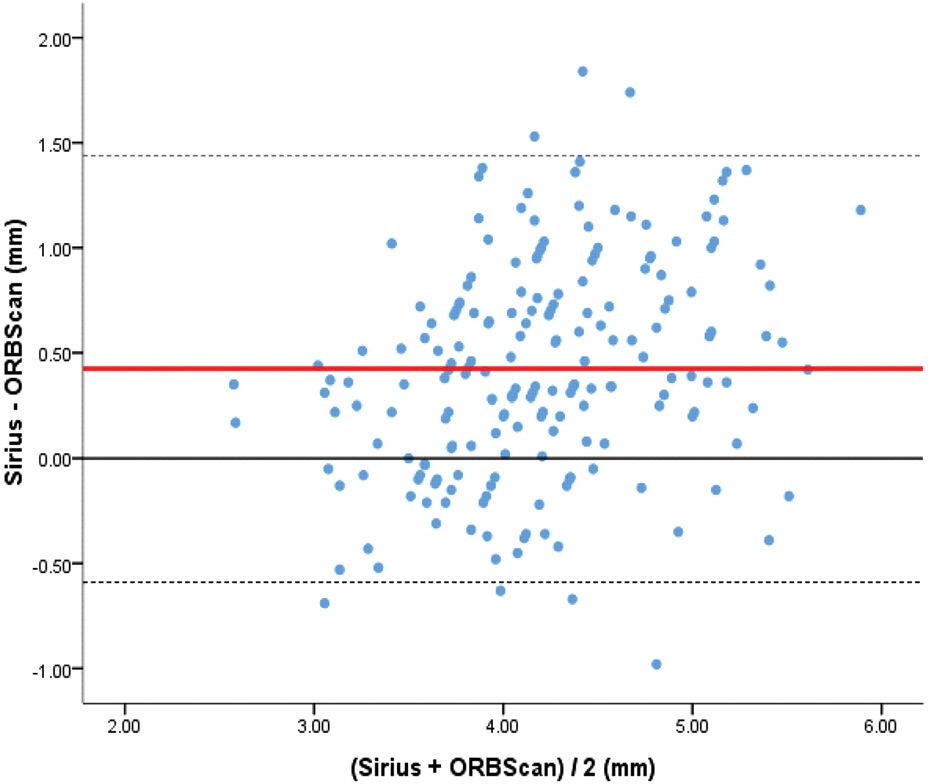J Korean Ophthalmol Soc.
2013 Aug;54(8):1175-1179.
Comparison of Colvardpupillometer, ORBScan II and Sirius in Determining Pupil Size for Refractive Surgery
- Affiliations
-
- 1Department of Ophthalmology, Konyang University, Kim's Eye Hospital, Seoul, Korea. jlchung@kimeye.com
- 2Daesung Yonsei Eye Clinic, Bucheon, Korea.
- 3Minduelre Eye Clinic, Daejeon, Korea.
Abstract
- PURPOSE
To compare pupil size measured by Colvard(R)pupillometer, ORBScan II(R), Sirius(R) and analyze correlation between pupil size and night vision disturbance after refractive surgery according to measuring methods.
METHODS
Two hundred eyes of one hundred patients who underwent refractive surgery were retrospectively evaluated. Pupil size was measured with Colvard(R)pupillometer, Sirius(R) in the scotopic light condition and with ORBScan II(R), Sirius(R) in the photopic light condition. Patients filled out questionnaire about night vision disturbance at postoperative three months. Correlation between pupil size according to measuring methods and night vision disturbance was evaluated.
RESULTS
The mean age of patient was 26 years and number of male patients was 36. In scotopic light condition, pupil size measured with Colvard(R)pupillometer (6.76 mm) was significantly larger than that of Sirius(R) (6.53 mm) (p < 0.001). In photopic light condition, pupil size measured with ORBScan II(R) (3.98 mm) was significantly smaller than that of Sirius(R) (4.41 mm) (p < 0.001). Night vision disturbance were correlated with pupil size and Sirius(R) in the scotopic light condition had strongest correlation among three measuring method (r = 0.44).
CONCLUSIONS
Sirius(R) tends to measure pupil size smaller than Colvard(R)pupillometer in the scotopic light condition. The correlation between night vision disturbance and pupil size was highest in Sirius(R).
MeSH Terms
Figure
Reference
-
References
1. Kim HM, Jung HR. Laser assisted in situ keratomileusis for high myopia. Ophthalmic Surg Lasers. 1996; 27:(5 Suppl). S508–11.2. Stephenson CG, Gartry DS, O’Brart DP. . Photorefractive keratectomy. a 6-year follow-up study. Ophthalmology. 1998; 105:273–81.
Article3. Pop M, Payette Y. Risk factors for night vision complaints after LASIK for myopia. Ophthalmology. 2004; 111:3–10.
Article4. Martinez CE, Appelegate RA, Klyce SD. . Effect of papillary dilation on corneal optical aberrations after photorefractive keratectomy. Arch Ophthalmol. 1998; 116:1053–62.5. Helgesen A, Hjortdal J, Ehlers N. Pupil size and night vision dis-turbances after LASIK for myopia. Acta Ophthalmol Scand. 2004; 82:454–60.
Article6. Mantry S, Banerjee S, Naroo S, Shah S. Scotopic measurement of normal pupil size with the Colvardpupillometer and the Nidek au-to-refractor. Cont Lens Anterior Eye. 2005; 28:53–6.7. Wang Y, Zhao K, Jin Y. . Changes of higher order aberration with various pupil sizes in the myopic eye. J Refract Surg. 2003; 19:(2 Suppl). S270–4.
Article8. Salz JJ, Trattler W. Pupil size and corneal laser surgery. Curr Opin Ophthalmol. 2006; 17:373–9.
Article9. Bland JM, Altman DG. Statistical methods for assessing agree-ment between two methods of clinical measurement. Lancet. 1986; 1:307–10.
Article10. Fan-Paul NI, Li J, Miller JS, Florakis GJ. Night vision disturbances after corneal refractive surgery. Surv Ophthalmol. 2002; 47:533–46.
Article11. Tahzib NG, Bootsma SJ, Eggink FA, Nuijts RM. Functional out-come and patient satisfaction after Artisan phakic intraocular lens implantation for correction of myopia. Am J Ophthalmol. 2006; 142:31–9.12. Chalita MR, Chavala S, Xu M, Krueger RR. Wavefront analysis in post-LASIK eyes and its correlation with visual symptoms, refraction, and topography. Ophthalmology. 2004; 111:447–53.
Article13. Kohnen T, Terzi E, Bühren J, Kohnen EM. Comparison of a digital and a handheld infrared pupillometer for determining scotopic pu-pil diameter. J Cataract Refract Surg. 2003; 29:112–7.
Article14. Rosen ES, Gore CL, Taylor D. . Use of a digital infrared pupill-ometer to assess patient suitability for refractive surgery. J Cataract Refract Surg. 2002; 28:1433–8.
Article15. Bootsma S, Tahzib N, Eggink F. . Comparison of two pupillometers in determining pupil size for refractive surgery. Acta Ophthalmol Scand. 2007; 85:324–8.
Article16. Pop M, Payette Y, Santoriello E. Comparison of the pupil card and pupillometer in measuring pupil size. J Cataract Refract Surg. 2002; 28:283–8.
Article17. Savini G, Barboni P, Carbonelli M, Hoffer KJ. Repeatability of au-tomatic measurements by a new Scheimpflug camera combined with Placido topography. J Cataract Refract Surg. 2011; 37:1809–16.
Article
- Full Text Links
- Actions
-
Cited
- CITED
-
- Close
- Share
- Similar articles
-
- Comparison of Corneal Measurement Values between Two Types of Topography
- Anterior Elevation Maps as the Screening Test for the Ablation Power of Previous Myopic Refractive Surgery
- Agreement of Actual Corneal Power and Corneal Power Using Topography in Cataract Patients Undergone Refractive Surgery
- Comparison of Anterior Segment Measurements Using Scanning-Slit Topography and Optical Low-Coherence Reflectometry (OLCR) Biometry
- Corneal Power Estimation Using Orbscan II Videokeratography in Eyes With Previous Corneal Refractive Surgeries




